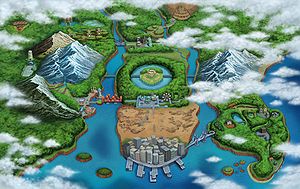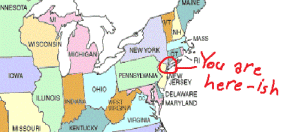Concept Corner Monochrome: The Unovian landscape
/ A whole new wooooooorrrllllld...Well, my fellow Black/White obsessors, here we are again, to talk about an aspect of the positively fergalicious new games we have been given by the gods of gaming at Nintendo. Black and White, like all new generational installments of the series, gives us a new region to nerd over(yes, nerd is now a verb). Let us do so now. If you haven't finished the game yet and don't want the entire world of the games ruined for you, turn back; here there be spoiler monsters. But don't worry, those who have only just finished defeating N for the final time, the only specific areas I'll be discussing are those found before completing the game.
A whole new wooooooorrrllllld...Well, my fellow Black/White obsessors, here we are again, to talk about an aspect of the positively fergalicious new games we have been given by the gods of gaming at Nintendo. Black and White, like all new generational installments of the series, gives us a new region to nerd over(yes, nerd is now a verb). Let us do so now. If you haven't finished the game yet and don't want the entire world of the games ruined for you, turn back; here there be spoiler monsters. But don't worry, those who have only just finished defeating N for the final time, the only specific areas I'll be discussing are those found before completing the game.
Black and White are set in a region called Unova, or Isshu in Japan. Unova is a word created using the latin words unum, meaning "one", and novus, meaning "new". The Japanese name Isshu comes from isshurui, meaning "one variety". This, as explained by game director Masuda, comes from the concept of Unova as a dense variety of races and species, but also veiwable as a single, unified mass of life. Unova is also the first region in the main series to have a completely diferrent name in Japanese than in english, possibly to convey to foreign audiences the sense of newness that the games are meant to have.
Unova is a mixture of urban and rural enviroments, as reflected in the version-specific Black City/White Forest, as well as the appearence of Opelucid City, which is rustic and old-style in White, and full of technology in Black. Unova's continent is seperated into three "fingers", which have a sort of dividing line between the metropolitan and rural areas. The center finger contains Castelia City and Nimbasa City, the major buisness and entertainment hubs of the region, as well as Opelucid, which, even in it's more rustic White form, is still a large and densely populated area. The outlying fingers contain the smaller but more abundant towns, as well as most of the routes and enviormental landmarks, such as Pinwheel Forest and Twist Mountain.
Sarting with the addition of the desert and dive areas in generation 3, a mentality seemed to be produced among some of us fans that each new generation would have to introduce at least one new enviromental area. Generation 5, however, doesn't really have one, or so it would seem. In the place of this, however, stand two things. The first is more obvious, and is something long talked about by wishful fans. I speak, of course, of the season cycle. The season cycle is great because it gives us new things to look at every month, as well as acess to new areas during the games winter periods. The second thing I speak of is one you may not have taken the time to think about: Reinvention.
What kind of reinvention am I talking about, you ask? Well, little Timmy, shut your mouth or I'll hit you again. Now, let me explain. In creating Unova, the design teams at Nintendo took the basic concepts of forests and caves, and added small but important things that would prove to make the old new again. The bridged, crater-like center of Twist Mountain, the magnet puzzle-ridden Chargestone Cave, and the twisting log-path of Pinwheel Forest all take an extra step to look and feel completely new.
Now, let's discuss the areas of the game in relation to the real world, shall we? Yes little Timmy, we shall, unless you want a good whipping. Do you want a good whipping? No? That's what I thought.
 At first glance, you would think the whole region is based off areas of New York, but you'd actually be mistaken. Only the middle "finger" of Unova is derived from New York. There we have Castelia and Nimbasa, based on lower and midtown Manhattan respectively, and Opelucid, based off the NYC neighborhood of Harlem, who's continual boom-and-bust cycles are a possible basis for Opelucid's appearence changes in the two games. The cities of the western "finger" are all based on areas of New Jersey. Driftveil is based on the buisness and commerce center of Union City, Mistralton on the airport-nessled city of Teterboro, and Icirrus on the hilly, contoured moor-like town of Ridgefield. These cities are, of course, not as well-known as NYCs various areas, but this gives a better feel of diversity to teh region. The locations on the eastern "finger" are actually a lot harder to place. There have been no official releases on the derivations of these locations, and fans have yet to put their collective fingers on any guesses. Geographically they're presumably based on areas of Connneticut, but that's about as spesific as we can get right now. Most of these towns, however, fall into the category of those I said I wouldn't talk about, the ones not explorable until post-game, so we don't need to worry about missing coverable ground.
At first glance, you would think the whole region is based off areas of New York, but you'd actually be mistaken. Only the middle "finger" of Unova is derived from New York. There we have Castelia and Nimbasa, based on lower and midtown Manhattan respectively, and Opelucid, based off the NYC neighborhood of Harlem, who's continual boom-and-bust cycles are a possible basis for Opelucid's appearence changes in the two games. The cities of the western "finger" are all based on areas of New Jersey. Driftveil is based on the buisness and commerce center of Union City, Mistralton on the airport-nessled city of Teterboro, and Icirrus on the hilly, contoured moor-like town of Ridgefield. These cities are, of course, not as well-known as NYCs various areas, but this gives a better feel of diversity to teh region. The locations on the eastern "finger" are actually a lot harder to place. There have been no official releases on the derivations of these locations, and fans have yet to put their collective fingers on any guesses. Geographically they're presumably based on areas of Connneticut, but that's about as spesific as we can get right now. Most of these towns, however, fall into the category of those I said I wouldn't talk about, the ones not explorable until post-game, so we don't need to worry about missing coverable ground.
Speaking of covered ground, little Timmy, that pretty much wraps us up for this exploration into the concepts of the newest region in the PokeGlobe. Unova is a great region that shall serve us well for the next few years. The basis on the US instead of Japan was an interesting creative move, one that served the purpose of "refreshing" the series very well. As for next time, we'll be looking at something that's a bit of a smaller scale, but with much larger ambitions, than the region of Unova. He's a little creepy, but oddly reassuring. He has long green hair and a black hat. His name is N, and next time on Monochrome we're going to take a look at him, the somewhat psychopathic sage who raised him, and the uprising-intent orginization they started.
Trapped in an endless Poke-void,
I'm IatosHaunted, signing off.
Concept Corner is (c) Jay Petrequin, 2011
